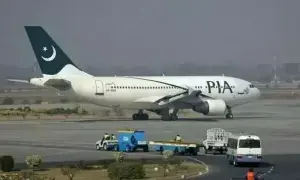Fog continues to disrupt lives across South Asia
A thick layer of fog has covered many areas of the country prompting authorities to close the roads, further increasing difficulties for the people.
Heavy fog and smog disrupted traffic on roads in areas of Sindh, Balochistan, and Punjab, especially in the morning. The low visibility caused problems for travellers.
The Met Office has forecasted that the region might continue receiving fog and smog for the next few days.
According to Aaj News, the authorities closed the M1 motorway which connects Peshawar to Burhan, the M5 motorway which connects Sher Shah to Rohri, and the Sawat expressway lies between Cornel Sher Khan and Ismailia.
The motorway police advised citizens to avoid unnecessary travel amid foggy weather.
The fog frequency increases in Pakistan, India, and Bangladesh in the winter season and the region has witnessed witnessed a rise in the density of fog over the last fewr decades which largely disturbs the daily lives as well as economic activity.
In the current situation, following the commencement of winter, fog geared up to spread in the region and enveloped areas of all three countries.
Flight disruption in Islamabad
Islamabad International Airport faced massive disruptions on Tuesday after fog limited visibility around the city.
Aviation sources said that a flight from Sharjah set to land in Islamabad had to be rerouted to Peshawar.
In addition, flights set to depart from Islamabad to Bahrain, London, Damam and Dubai had to be delayed.
Airport authorities told the public that they should seek information before turning up at the airport.
India
India has also been undergoing with same situation since the winter get-in in the region.

At least 21 trains will run late as the fog engulfed parts of Dehli, Uttar Pradesh, and Rajasthan on the first day of New Year. Additionally, in a bid to protect children from the fog, the government of India Punjab changed school timing from January 1.
Bangladesh
Dense fog persisted in Bangladesh as well, where the meteorologist department predicted a decline in day and night temperature with a partly clouded sky. Here continuation of air navigation, inland river transport and road travel is at risk due to the thick fog.

Cause and solution
A report published by Reuters in November attributed air pollution to a marked increase in economic activities, especially in the industrialization over the past two decades, leading to increased demand for energy and fossil fuels.
Smoke from the factories and vehicles is a major contributor giving strength to the pollution which converts itself into smog in the winter with the help of high levels of humidity in the air.
The report further focused on the reasons for smog or fog getting stronger due to the multiplication of vehicles on the road also exacerbated the pollution problem.
Additionally, the report noted that the Asian countries keep trying to curb pollution, putting plans together to forestall the pollution; they also installed air quality monitors but this initiative would not be fruitful, as experts believe that the problem lies in a lack of coordination between the countries.
Countries across South Asia will have to coordinate efforts if the region’s pollution problem is to be solved, collaborating to enhance monitoring and make policy decisions.
At the same time, these region-wide efforts will have to be balanced by molding solutions to suit local conditions where needed.
For the latest news, follow us on Twitter @Aaj_Urdu. We are also on Facebook, Instagram and YouTube.
















Comments are closed on this story.